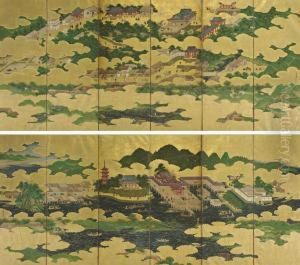Kano Masunobu Paintings
Kano Masunobu was a Japanese painter and the founder of the Kano school of Japanese painting, one of the most famous and historically significant art schools in Japan. Born in 1434, Masunobu served under the patronage of the Ashikaga shogunate, particularly under the rule of Ashikaga Yoshimasa, who was a great patron of the arts and the initiator of the Higashiyama culture, which had a profound influence on the aesthetics and culture of Japan.
As a painter, Masunobu's style was characterized by its blend of Chinese and Japanese elements. He was heavily influenced by Chinese Song and Yuan dynasty landscape painting as well as Zen Buddhism. His works often incorporated Chinese techniques and motifs, which he adapted and infused with a distinctly Japanese sensibility. Masunobu's paintings are known for their use of ink monochrome (sumi-e), although he also worked with light color on occasion.
Masunobu trained many artists, including his own son Kano Motonobu, who would later lead the Kano school to even greater heights. The Kano school dominated Japanese painting from the late 15th century until the end of the Edo period, with members of the Kano family serving as official painters to the shogun. They worked on a wide variety of commissions, ranging from fusuma (sliding door) and byobu (folding screen) paintings for castles and temples to works on paper and scrolls.
Despite the lack of extant works confidently attributed to Masunobu, his influence is undeniable. Through his teaching and the establishment of the Kano school, his impact on the trajectory of Japanese painting was profound. The Kano school's emphasis on learning from the past while developing new expressions continued to shape Japanese art for centuries.
Kano Masunobu passed away in 1530, but the legacy of his artistic vision and the school he founded endured, with the Kano school remaining the preeminent force in Japanese painting well into the 19th century. The Kano school's style and teachings were passed down through generations, and many works by later Kano artists reflect the artistic principles first put forth by Masunobu.
